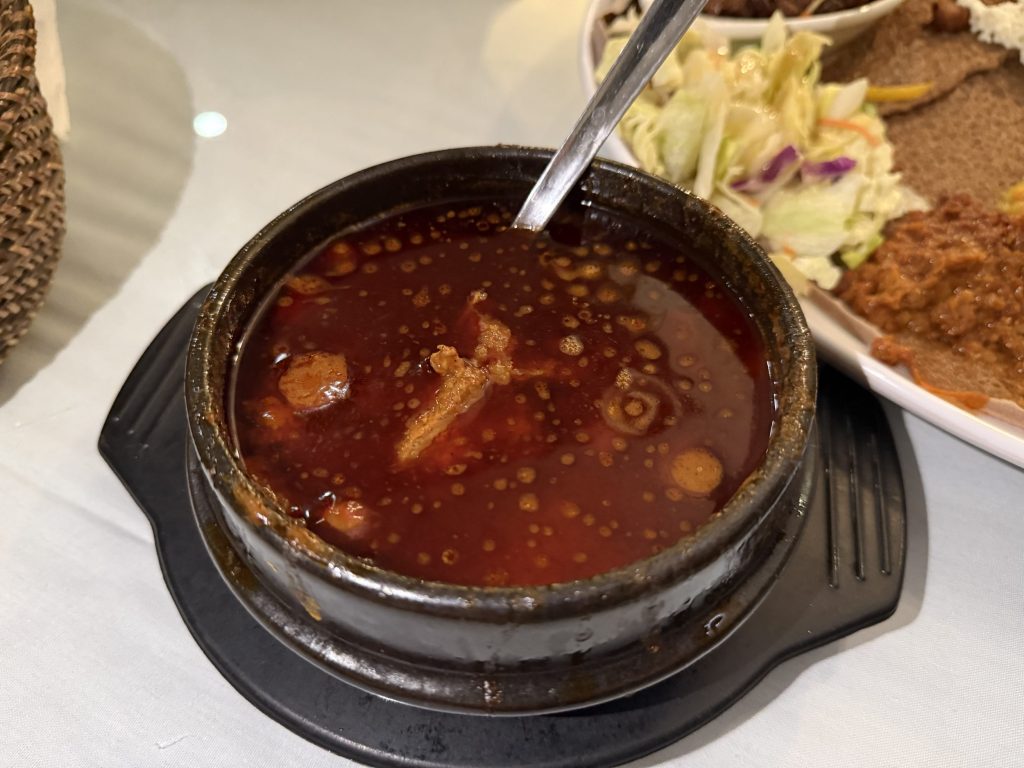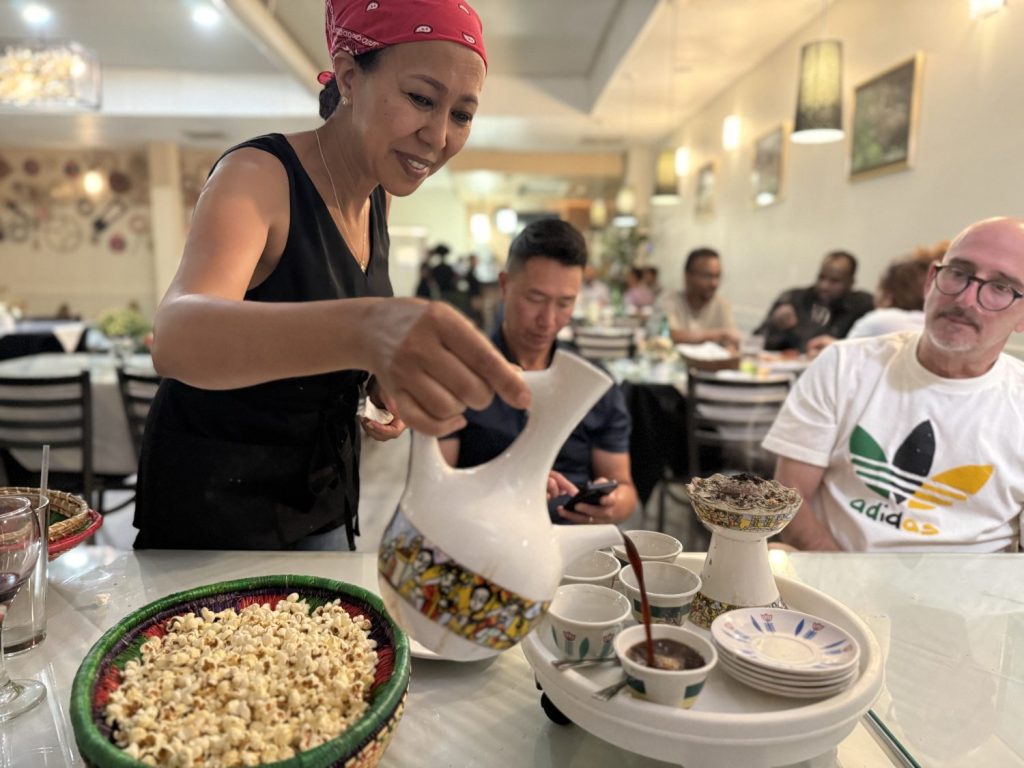
Courtesy of Nile Ethiopian

Audio By Carbonatix
Over a decade ago, former Westword food editor Mark Antonation began his food-writing career by eating his way up Federal Boulevard. Now, we’re turning our attention to another vibrant culinary corridor.
The four-plus-mile stretch of Havana Street between Dartmouth and Sixth Avenue in Aurora is home to the most diverse array of international cuisine available in the metro area. From restaurants and markets to take-and-go shops and stands, food lovers of nearly any ethnicity or interest can find a place that will remind them of home or open new culinary doors. In Eat Up Havana, Antony Bruno will visit them all, one by one, week by week. Check out his previous stops.
This week, Bruno visits Nile Ethiopian Restaurant

Antony Bruno
This year, make your gift count –
Invest in local news that matters.
Our work is funded by readers like you who make voluntary gifts because they value our work and want to see it continue. Make a contribution today to help us reach our $50,000 goal!
Eat at enough restaurants along Aurora’s Havana Street and a few patterns start to emerge. Among the strongest of them, shared by multiple establishments of different cultures and cuisines, is a desire by immigrant owners to share a piece of their homeland with diners.
Sometimes those diners are fellow expats searching for a little slice of home in a foreign land. Others are their second-generation children seeking a connection to their ancestral cuisine. And still others are curious tourists there to appreciate something new, different and most of all, delicious.
Few places along Havana Street embody this spirit more than Nile Ethiopian Restaurant.
For many, this is no secret. Nile has proven a perennial favorite of the Denver metro area for nearly twenty years. In 2018, it was our Best of Denver pick for Best Ethiopian Restaurant, and it is a mainstay on any roundup of go-to African restaurants in the city.
But what many don’t know is that the restaurant changed hands about two years ago. Today, it is run by Azeb Haile, the original owner’s sister, who by all accounts is both keeping and fanning the flame that fuels the restaurant’s enduring legacy.
Haile immigrated to the United States in 2004, working as a mom, a translator, and in real estate. But all the while, her goal was to get back into the kitchen and continue cooking her food for as many people as she could.
“My mom taught us, all of us. It’s her legacy,” Haile says. “She loved cooking, and she taught us when I was maybe six years old. It became my passion. I enjoy cooking, and I love serving people.”
That’s immediately obvious to anyone fortunate enough to meet her. Throughout service on any given night, she occasionally emerges from the kitchen to greet guests, her happiness radiating like an aura and her smile connecting like a hug.
And of course, there’s the food, which is almost addictive in its variety of colors, flavors and textures — the hallmark of Ethiopian cuisine.

Antony Bruno
A Feast for All Senses
Even those who’ve never been to an Ethiopian restaurant have likely heard that the cuisine is served communally, on a large tray of spongy bread called injera, made from a naturally gluten-free teff flour that gives it a dark, cloudy color.
In lieu of using silverware, the idea is to tear a piece of bread and use it to scoop up the various family-style dishes you’ve ordered. This is no mere gimmick meant to attract diners seeking an “exotic” experience. The spongy texture of the injera is ideal for absorbing the flavorful sauces and stews. The sourness of the fermented bread offers a welcome contrast to the richly spiced foods. And speaking of fermentation, the natural probiotics of the injera promote healthy digestion of the often massive feasts that come out of this kitchen.
As for what you’re scooping up with this spongy bread, look for a mix of vegetables, stews and meats. A smart place to start here is with the vegetarian combo, a beautiful selection of chickpeas, lentils, potatoes, beans, cheese and salads that could easily serve as a main dish for two, but is more commonly used as a complement to the many carnivorous options on the menu.

Antony Bruno
Of the meat-focused fare, a few highlights include the lamb derek tibs, which are cubed pieces of lamb fried almost like chicharróns and sauteed with onions, tomatoes and peppers. There are also several types of wot (basically stews), such as a chicken wot marinated in lemon, sauteed in butter, then stewed with a deeply flavored red pepper sauce. You’ll be fighting your table for every bite.
And finally, don’t shy away from the kitfo, an Ethiopian steak tartare. Yes…raw meat, but it eats almost like a sausage — incredibly tender, aggressively spiced and so rich that only a few bites per person is enough for a table of four.
When all are presented at the table at the same time, the meal is a wonderful medley of sights, flavors and textures. The more you reach over each other to grab a pinch of a pile of lentils or a bowl of lamb, the closer you are. And as your eyes meet, you silently raise an eyebrow and shake your head in wonder and shared appreciation.

Antony Bruno
With every bite, you can tell each component is made fresh by people who care.
“Everything here we cook from scratch and we serve with love,” says Haile, who declines to highlight a specific best seller or special to promote. “It’s like you can’t choose from your kids which one you love most.”
The Coffee Ceremony
Whether your dining choices lean more towards vegan or carnivorous options, a can’t-miss way to end the meal is with the traditional coffee ceremony, or buna. The coffee beans are roasted in a pot in the restaurant and brought to your table so you can breathe in the aroma (a process that often sets off the fire alarm). The beans are then ground, brewed and served in a ceramic kettle with handle-less cups on a tray, along with incense and popcorn.

Antony Bruno
Traditionally, the coffee is served in three rounds, and there’s certainly enough brewed for each table to take your time and enjoy the almost espresso-like richness of the coffee. The popcorn is an interesting and welcome touch that serves as a perfect contrast.
The coffee ceremony is just one of many little touches that Nile Ethiopian offers to deliver a truly memorable experience. The walls feature framed photos of Ethiopian landmarks and monuments. One corner of the space is reserved in the style of mesob wicker tables, chairs and cushions, with traditional serving and cooking utensils on the walls. The restaurant is often full, as many graduations, birthday parties, weddings and other special events are held here.
Overall, it’s a place you’ll find yourself lingering in to enjoy both the food and the people. It’s not designed to turn tables quickly. It’s more a place to enjoy a taste of home, regardless of whether it’s a home you grew up in or one you’re visiting for the first time.
“The moment you order, we start cooking,” Haile says. “It’s not like other food you can warm up and serve. It takes a little longer compared to other places, but it’s worth it. We do it intentionally.”
Nile Ethiopian Restaurant is located at 1951 South Havana Street in Aurora and is open from 11 a.m to 9 p.m. daily, closed Wednesdays. For more information, visit nileethiopianrestaurantcolorado.com.
All the previous Eat Up Havana stops:
- Old Town Hot Pot
- Leezakaya
- Chutney Indian Cuisine
- El Tequileno
- Milkroll
- Shin Myung Gwan Korean BBQ
- Watan Restaurant & Bakery
- Las Fajitas
- Mr. Tang
- Nana’s Dim Sum & Dumplings
- Yemen Grill
- Tofu House
- Sushi Katsu
- Coco Loco
- Ali Restaurant & Bakery
- Thank Sool Pocha
- Taqueria Corona
- Hanyang Wang Jokbal
- Coffee Story
- Tofu Story
- Havana Street Night Markets
- Seoul BBQ & Hot Pot (the Hot Pot)
- Seoul BBQ & Hot Pot (the BBQ)
- Pho 75
- Yong Gung
- Chopsticks A GoGo
- Angry Chicken
- L Cafe & Food Court
- Gangnam GT Lounge & Karaoke
- Katsu Ramen
- Dae Gee
- Snowl
- Chef Liu’s Kitchen
- Piramides